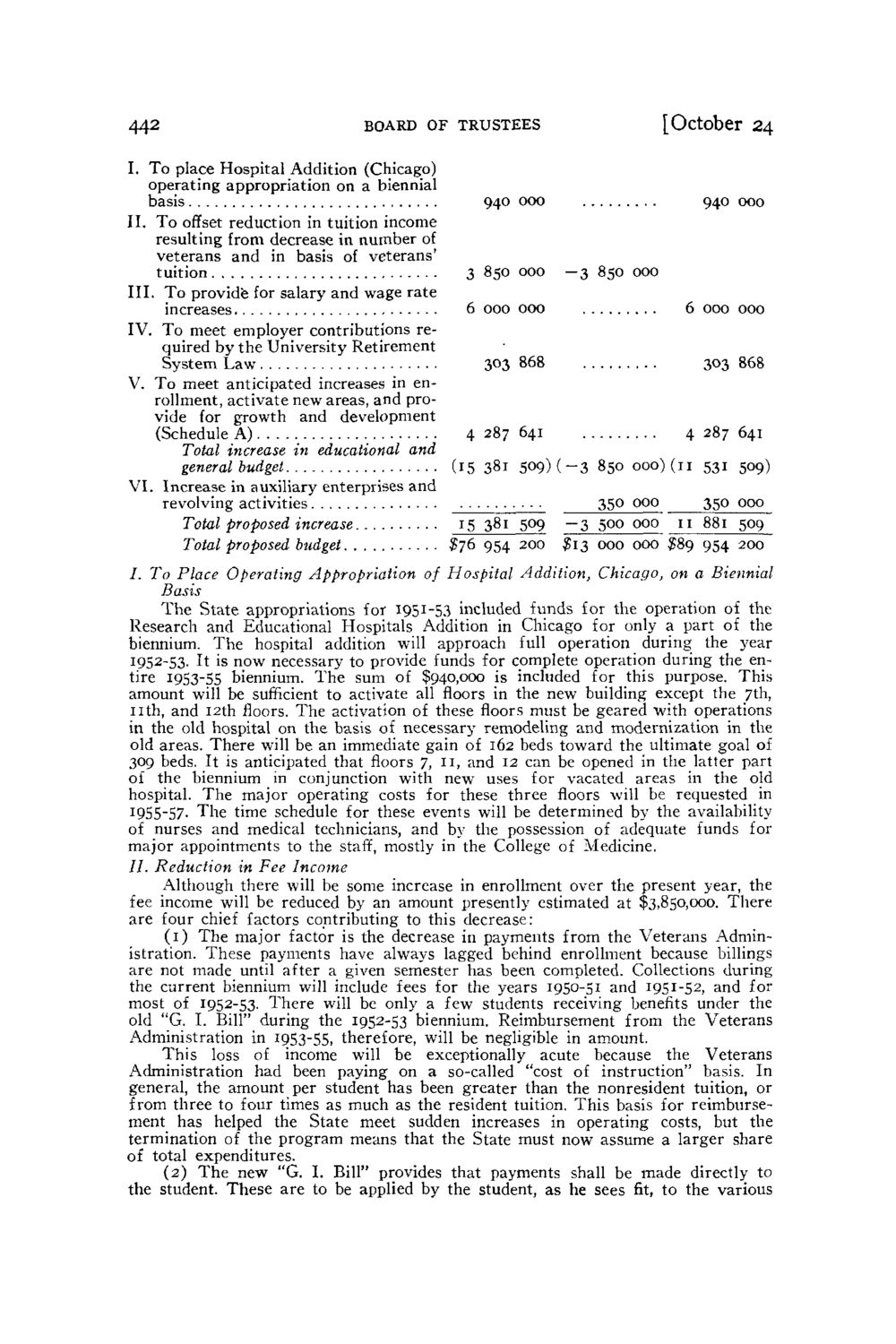| |
| |
Caption: Board of Trustees Minutes - 1954
This is a reduced-resolution page image for fast online browsing.

EXTRACTED TEXT FROM PAGE:
442 BOARD OF TRUSTEES [October 24 I. To place Hospital Addition (Chicago) operating appropriation on a biennial basis 940 000 II. To offset reduction in tuition income resulting from decrease in number of veterans and in basis of veterans' tuition 3 850 000 III. To provide for salary and wage rate increases 6 ooo ooo IV. To meet employer contributions required by the University Retirement System Law 303 868 V. To meet anticipated increases in enrollment, activate new areas, and provide for growth and development (Schedule A) 4 287 641 Total increase in educational and general budget (15 381 509) VI. Increase in auxiliary enterprises and revolving activities Total proposed increase 15 381 509 Total proposed budget $76 954 200 940 000 —3 850 000 6 ooo ooo 303 868 4 287 641 ( - 3 850 000) (11 531 509) 350 000 350 000 —3 500 000 11 881 509 $13 000 000 $89 954 200 / . To Place Operating Appropriation of Hospital Addition, Chicago, on a Biennial Basis The State appropriations for 1951-53 included funds for the operation of the Research and Educational Hospitals Addition in Chicago for only a part of the biennium. The hospital addition will approach full operation during the year ^SZSZ- It is now necessary to provide funds for complete operation during the entire 1953-55 biennium. The sum of $940,000 is included for this purpose. This amount will be sufficient to activate all floors in the new building except the 7th, n t h , and 12th floors. The activation of these floors must be geared with operations in the old hospital on the basis of necessary remodeling and modernization in the old areas. There will be an immediate gain of 162 beds toward the ultimate goal of 309 beds. It is anticipated that floors 7, n , and 12 can be opened in the latter part of the biennium in conjunction with new uses for vacated areas in the old hospital. The major operating costs for these three floors will be requested in J O ^ ^ - The time schedule for these events will be determined by the availability of nurses and medical technicians, and by the possession of adequate funds for major appointments to the staff, mostly in the College of Medicine. 11. Reduction in Fee Income Although there will be some increase in enrollment over the present year, the fee income will be reduced by an amount presently estimated at $3,850,000. There are four chief factors contributing to this decrease: (1) The major factor is the decrease in payments from the Veterans Administration. These payments have always lagged behind enrollment because billings are not made until after a given semester has been completed. Collections during the current biennium will include fees for the years 1950-51 and 1951-52, and for most of 1952-53. There will be only a few students receiving benefits under the old "G. I. Bill" during the 1952-53 biennium. Reimbursement from the Veterans Administration in 1953-55, therefore, will be negligible in amount. This loss of income will be exceptionally acute because the Veterans Administration had been paying on a so-called "cost of instruction" basis. In general, the amount per student has been greater than the nonresident tuition, or from three to four times as much as the resident tuition. This basis for reimbursement has helped the State meet sudden increases in operating costs, but the termination of the program means that the State must now assume a larger share of total expenditures. (2) The new "G. I. Bill" provides that payments shall be made directly to the student. These are to be applied by the student, as he sees fit, to the various
| |